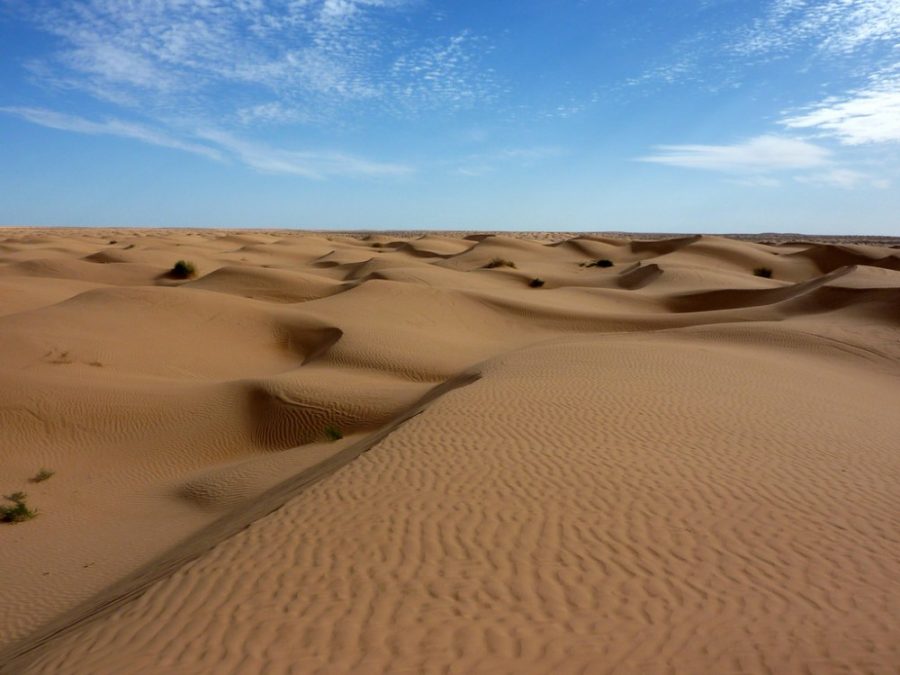In the north of Africa lies the Sahara Desert. It spans ten countries, three massive bodies of water and nearly 3.5 million square miles of land. It covers nearly 10 percent of Africa’s landmass and is the world’s largest hot desert.
Recently, a team of UA scientists confirmed that this was not always the case. New marine sediment analysis reveals that at one point the area that is now the Sahara Desert once got an average of 25 inches of rainfall per year. That is almost as much as the city of Seattle.
The team of scientists, lead by associate professor of geoscience Jessica Tierney, have published a paper named “Rainfall Regimes of Green Sahara,” examining the rainfall patterns of this ancient oasis.
RELATED: UA experts discuss the state of buffelgrass around Tucson
“The Green Sahara represents the biggest change in climate globally during the recent Holocene epoch,” said Tierney in an interview with the Daily Wildcat’s Hannah Dahl. Between 5,000 and 11,000 years ago this rainfall allowed for hunter-gatherers to prosper in northern Africa.

There has been evidence of this Green Sahara previously, but Tierney and her team were able to establish a better anthropological timeline than was previously understood. Archaeological evidence showed that the people of the Sahara left 8,000 years ago, 3,000 years before the end of the green Sahara period. Something didn’t add up.
This was an issue within the geological timeline of the area. However, the rainfall study done by Tierney and her team found that within the Green Sahara period there was a drastic 1,000-year dry period.
“Going into this research, we didn’t actually suspect that there would be a prolonged “pause” in Green Sahara conditions around 8,000 years ago, but that is what we found,” Tierney said. “It wasn’t as dry then as it is today, but it was substantially dryer that the periods either before or after the event.”
One problem that left the Green Sahara period geologically ambiguous is the lack of erosion-protected areas. Geologists would typically take sediment cores beneath bodies of water to get an accurate picture of the past. But any lakes that were once a part of Green Sahara have long since dried up and the sediment that once lay below has experienced 5,000 years of erosion according to Tierney.
The solution? Analyze a few sediment cores from the Atlantic, off the coast of northwest Africa. There the sediment will have been preserved and provide accurate and representative data.
RELATED: Flying the friendly skies: UA scientists use airplanes to research climate change
In order to interpret the findings from the sediment, Tierney and her team had to calculate the presence of ancient wax left by plants during this period.
“These waxes are useful for paleoclimate because they actually record how wet or dry it was in the past in their chemical composition, specifically in the ratio of hydrogen isotopes in the molecules,” Tierney said.
These hydrogen isotopes vary in accordance with the amount of rainfall. When there was heavier rainfall the resulting plant wax would have a heavier hydrogen isotope called deuterium. Conversely, less rainfall would result in a higher frequency of the light, regular hydrogen, explained Tierney.
This information is incredibly useful for understanding the climate patterns of the Sahara. The discoveries made by the research team have allowed them to factor in the secondary effects stemming from climate change, like vegetation and dust. In essence, an initially small increase in rainfall would increase the amount of vegetation and reduce the amount of dust which in turn would provide the conditions that would result in more rainfall.
“For example, if global warming results in an increase in rainfall in the region, the increase could be even bigger than expected due to these vegetation and dust feedbacks,” Tierney said. “Conversely, if global warming will bring drought, then it could be exacerbated by changes in vegetation and dust. Understanding this is important for predicting future climate change in regions like the Sahara and the Sahel.”
Follow Chandler Donald on Twitter.









